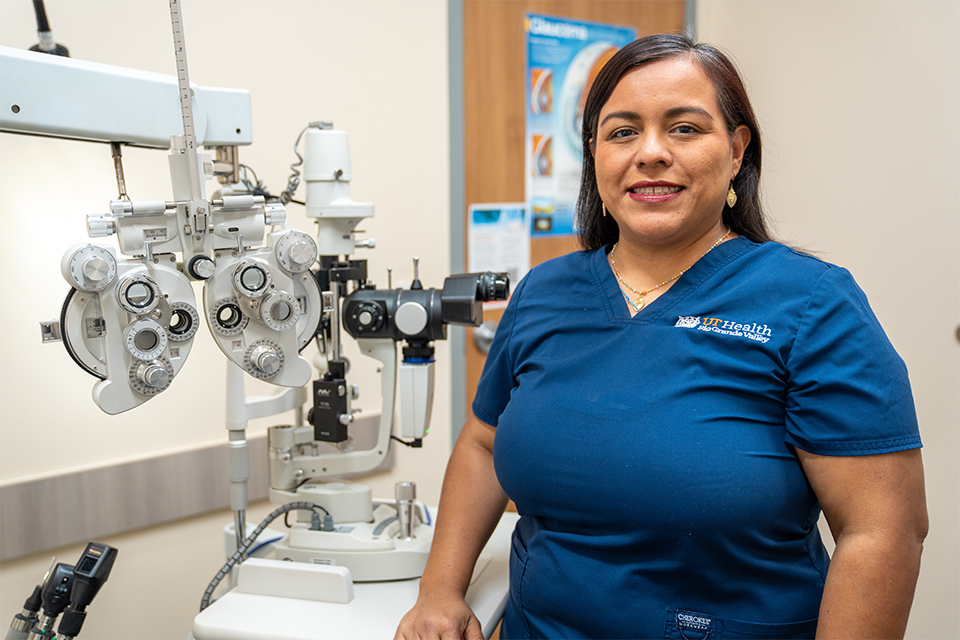By Heriberto Perez–Zuñiga
RIO GRANDE VALLEY, TEXAS – JUNE 17, 2025 – You’re driving down the road when headlights start to glare a little more than usual. Night driving feels tougher, and street signs appear less sharp. Things that once seemed bright now look dull or hazy.
If this sounds familiar, it may be more than just aging eyes; it could be a sign of cataracts.
June is Cataract Awareness Month, and Dr. Lorena Flores-Hernandez, an optometrist and glaucoma specialist at UT Health RGV, wants Rio Grande Valley communities to know that cloudy vision doesn’t have to be a part of aging.
“Cataracts tend to develop slowly and are most often age-related, but they can also be caused by diabetes, trauma, certain medications or even prolonged UV exposure,” Flores-Hernandez said. “They’re very common, especially after age 55, but they are also very treatable.”
RECOGNIZING THE SIGNS
A cataract is the clouding of the eye’s natural lens, gradually blurring vision. It can feel like looking through a foggy window: colors lose their brightness, glare intensifies and night vision may deteriorate.
In the early stages, cataracts may not cause noticeable symptoms. Over time, they can interfere with everyday activities like reading, driving or recognizing faces.
“Blurry vision, increased light sensitivity and frequent changes in your glasses prescription are all signs to watch for,” Flores-Hernandez said. “If you’re noticing any of those changes, it’s time to schedule an eye exam.”
According to the National Eye Institute, more than 24.4 million Americans aged 40 and older have cataracts, a number projected to rise to 50 million by 2050. People with diabetes are 2 to 5 times more likely to develop cataracts earlier and more rapidly than those without the condition.
That is particularly concerning for the Rio Grande Valley, where approximately 26.7% of adults have been diagnosed with diabetes – significantly higher than the national average of 14.7% according to the Centers for Disease Control and Prevention (CDC).
EARLY DETECTION
Flores-Hernandez emphasizes that Valley residents, especially older adults and individuals with diabetes, are at higher risk and should prioritize their eye health.
A comprehensive eye exam is the best way to detect cataracts early. These checkups assess visual acuity, eye pressure, retinal health and glare sensitivity.
“If cataracts are interfering with your daily life or affecting your eye health, we refer patients for surgery, which replaces the cloudy lens with an artificial one,” she said. “It’s a safe, common procedure that dramatically improves vision for most people.”
While cataracts aren’t always preventable, Flores-Hernandez suggests several ways to reduce risk and potentially slow their progression:
- Wear sunglasses to protect against UV rays.
- Maintain a healthy diet rich in fruits and vegetables.
- Quit smoking and limit alcohol consumption.
- Manage chronic conditions like diabetes.
- Get regular eye exams as recommended.
Flores-Hernandez encourages Valley residents to prioritize their eye health, not just for now, but for the future.
“Vision is one of our most precious senses,” she said. “Many people delay care because they think blurry vision is just a part of getting older, but it doesn’t have to be.”
Need an eye exam? Visit UTHealthRGV.org to schedule one today and learn more.
ABOUT UTRGV
The University of Texas Rio Grande Valley (UTRGV) was created by the Texas Legislature in 2013 as the first major public university of the 21st century in Texas. This transformative initiative provided the opportunity to expand educational opportunities in the Rio Grande Valley, including a new School of Medicine and a School of Podiatry, and made it possible for residents of the region to benefit from the Permanent University Fund – a public endowment contributing support to the University of Texas System and other institutions.
UTRGV has campuses and off-campus research and teaching sites throughout the Rio Grande Valley including Brownsville (formerly The University of Texas at Brownsville campus), Edinburg (formerly The University of Texas-Pan American campus), Harlingen, Weslaco, McAllen, Port Isabel, Rio Grande City and South Padre Island. UTRGV, a comprehensive academic institution, enrolled its first class in the fall of 2015; the School of Medicine welcomed its first class in the summer of 2016, and the School of Podiatric Medicine in the fall of 2022.

